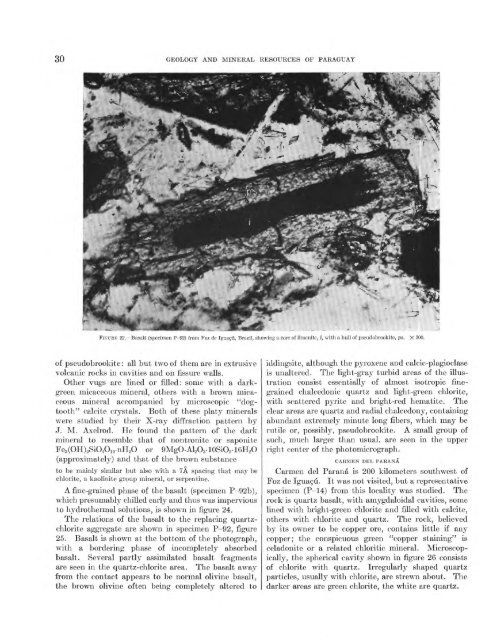Geology and Mineral Resources of Paraguay A Reconnaissance
Geology and Mineral Resources of Paraguay A Reconnaissance
Geology and Mineral Resources of Paraguay A Reconnaissance
- No tags were found...
Create successful ePaper yourself
Turn your PDF publications into a flip-book with our unique Google optimized e-Paper software.
30 GEOLOGY AND MINERAL RESOURCES OF PARAGUAYFIGURE 22. Basalt (specimen P-92) from Foz de Iguacu, Brazil, showing a core <strong>of</strong> ilmenite, i, with a hull <strong>of</strong> pseudobrookite, ps. X 300.<strong>of</strong> pseudobrookite: all but two <strong>of</strong> them are in extrusivevolcanic rocks in cavities <strong>and</strong> on fissure walls.Other vugs are lined or filled: some with a darkgreenmicaceous mineral, others with a brown micaceousmineral accompanied by microscopic "dogtooth"calcite crystals. Both <strong>of</strong> these platy mineralswere studied by their X-ray diffraction pattern byJ. M. Axelrod. He found the pattern <strong>of</strong>" the darkmineral to resemble that <strong>of</strong> nontronite or saponiteFe2 (OH) 2SiO4O10-nH2O or 9MgO-Al2O3-10SiO2.16H2O(approximately) <strong>and</strong> that <strong>of</strong> the brown substanceto be mainly similar but also with a 7A spacing that may bechlorite, a kaolinite group mineral, or serpentine.A fine-grained phase <strong>of</strong> the basalt (specimen P-92b),which presumably chilled early <strong>and</strong> thus was imperviousto hydro thermal solutions, is shown in figure 24.The relations <strong>of</strong> the basalt to the replacing quartzchloriteaggregate are shown in specimen P-92, figure25. Basalt is shown at the bottom <strong>of</strong> the photograph,with a bordering phase <strong>of</strong> incompletely absorbedbasalt. Several partly assimilated basalt fragmentsare seen in the quartz-chlorite area. The basalt awayfrom, the contact appears to be normal olivine basalt,the brown olivine <strong>of</strong>ten being completely altered toiddingsite, although the pyroxene <strong>and</strong> calcic-plagioclaseis unaltered. The light-gray turbid areas <strong>of</strong> the illustrationconsist essentially <strong>of</strong> almost isotropic finegrainedchalcedonic quartz <strong>and</strong> light-green chlorite,with scattered pyrite <strong>and</strong> bright-red hematite. Theclear areas are quartz <strong>and</strong> radial chalcedony, containingabundant extremely minute long fibers, which may berutile or, possibly, pseudobrookite. A small group <strong>of</strong>such, much larger than usual, are seen in the upperright center <strong>of</strong> the photomicrograph.CARMEN DEL PARANACarmen del Parana is 200 kilometers southwest <strong>of</strong>Foz de Iguagu. It was not visited, but a representativespecimen (P-14) from, this locality was studied. Therock is quartz basalt, with amygdaloidal cavities, somelined with bright-green chlorite <strong>and</strong> filled with calcite,others with chlorite <strong>and</strong> quartz. The rock, believedby its owner to be copper ore, contains little if anycopper; the conspicuous green "copper staining" isceladonite or a related chloritic mineral. Microscopically,the spherical cavity shown in figure 26 consists<strong>of</strong> chlorite with quartz. Irregularly shaped quartzparticles, usually with chlorite, are strewn about. Thedarker areas are green chlorite, the white are quartz.
















